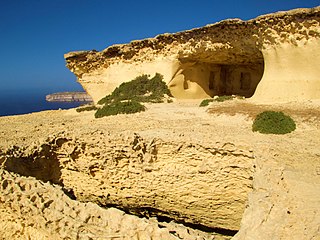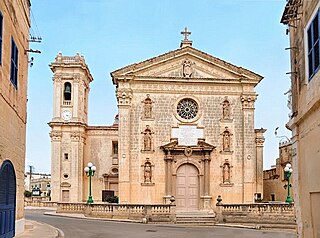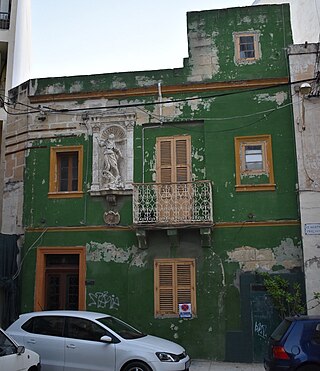This is a list of monuments in Fontana , Gozo, Malta, which are listed on the National Inventory of the Cultural Property of the Maltese Islands. [1] [2] [3] [4] [5]

Gudja is a village in the Southern Region of Malta, with a population of 3,148 as of March 2017. The village is located on high grounds, south of Valletta. It is administered by the Gudja Local Council. A number of schools, clubs, public gardens and recreations places are found around the village.

Fontana is an administrative unit of Malta, on the island of Gozo, with a population of 985 people.
Malta is the country with the most holidays in the European Union. Since 2020, any holidays falling on Saturdays or Sundays add an extra day to the workers' leave pool, reverting to the pre 2005 system.

St Helen's Basilica is an 18th-century Roman Catholic church situated in Birkirkara, Malta. It is built on the baroque design by Salvu Borg and built by Mason Domenico Cachia. The design was inspired, and is similar, to the Mdina Cathedral by Lorenzo Gafa. It was built to replace the role of the main old Parish Church of St. Mary that was damaged in the 1856 earthquake. It eventually became the Collegiate Church and then a Minor Basilica. The current parish archpriest is Mons Louis Suban.

The Basilica of St Dominic or also known as the Basilica of Our Lady of Safe Haven and St Dominic is one of the three parish churches of Valletta, Malta. It is administered by the Dominican Order whose convent is located behind the church.

The Basilica of Our Lady of Mount Carmel is a Carmelite Roman Catholic minor basilica dedicated to Our Lady of Mount Carmel, located in Valletta, Malta. It is one of the major churches of Valletta, and it forms part of a UNESCO World Heritage Site which includes the entire city. The present church was constructed between 1958 and 1981 on the site of a late 16th century church which was destroyed during World War II.

The Parish Church of St Philip of Agira is a Roman Catholic parish church in Żebbuġ, Malta, dedicated to Saint Philip of Agira.

The National Inventory of the Cultural Property of the Maltese Islands (NICPMI) is a heritage register listing the cultural property of Malta. The inventory includes properties such as archaeological sites, fortifications, religious buildings, monuments and other buildings. The NICPMI is under the responsibility of the Superintendence of Cultural Heritage (SCH), which was founded in 2002 to replace the Antiquities Act. The NICPMI was established on 16 December 2011.

The Church of Our Lady of Liesse is a church in Valletta, Malta. The church was built in 1740 on the site of a 17th-century church. The cupola was built to the designs of the Maltese Architect Francesco Zammit. The church is located near the shores of the Grand Harbour, close to Lascaris Battery and the site of the fish market. It is especially venerated by the people of the port area.

The Saint Publius Parish Church, also known as the Floriana Parish Church is a Roman Catholic parish church in Floriana, Malta, dedicated to Saint Publius. It was constructed at several stages between the 18th and 20th centuries.

Ras il-Wardija is a promontory in the limits of San Lawrenz, on the southwest coast of Gozo, Malta. It contains the remains of a Punic-Roman sanctuary, which was excavated by Italian archaeologists in the 1960s. The area is privately owned and it is currently in a dilapidated state.

The Parish Church of Saint Mary, commonly known as il-Knisja l-Qadima is a Roman Catholic parish church in Birkirkara, Malta, dedicated to the Assumption of Mary. It was built in the 17th century, and it has a Renaissance design attributed to the architects Vittorio Cassar and Tommaso Dingli.

The Parish Church of Saint Mary is a Roman Catholic parish church in Attard, Malta, dedicated to the Assumption of Mary. Built between 1613 and 1624, the church is attributed to the architect Tommaso Dingli and it is regarded as the finest Renaissance church in Malta. It still retains its original design, with the exception of a belfry and two sacristies which were added in the 18th and 19th centuries.

The Church of the Nativity of Our Lady, commonly known as ta' Ġieżu, is a Roman Catholic church in Rabat, Malta. The church was built in 1500 and it was enlarged in 1757. It is adjoined by a Franciscan convent.

The Green House was a late 19th-century vernacular townhouse in Sliema, Malta. The historic residence was an icon in the area, situated at the end of St Mary Street of which name of street derives from the niche on the façade of the building. The façade was notably characterized by its dark green colour which had made it a noticeable landmark. The niche of the Assumption of Our Lady, dated to 1875, is listed on the National Inventory of the Cultural Property of the Maltese Islands (NICPMI).